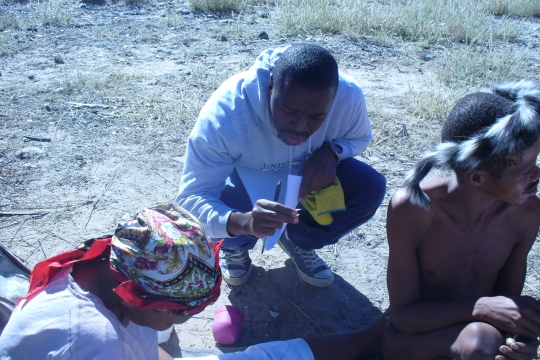Africa’s wild animals are the world’s heritage, but they live on the land of indigenous peoples. Researchers at EfD-South Africa have been working with the South African National Parks agency (SANParks) on the challenge of balancing conservation, affordability, and community land rights in the nation’s famous wildlife areas.
The Kgalagadi Transfrontier Park (KTP) was the setting for EfD research on these questions. This park, with land in both South Africa and neighboring Botswana, is home to lions and leopards, two of the so-called Big Five animals that attract international tourism, as well as huge herds of gemsbok. It is also home to the Khomani San and Mier peoples. “The South African government restored land rights in the park to these two communities as part of post-apartheid land restitution,” explained EfD researcher Johane Dikgang. “It is the shared obligation of SANParks and the traditional residents to manage the parks, with goals of both conserving the ecosystem and improving livelihoods in these communities, where most people are poor.”
The Khomani San lost more land than the Mier when the park was created during the apartheid era, and therefore have received more land rights under restitution. For instance, the Khomani can enter KTP for free. Other visitors, including Mier, pay a fee. The fee is higher for international visitors than for South African residents.
When EfD’s research project started in 2011, South Africans paid 45 Rand per person per day (less than US $6) to enter KTP. “South Africans make up 80% of the visitors to the park,” said Dr. Dikgang. “Both domestic and foreign visitors to remote parks such as KTP tend to be relatively well-off. For both groups, the entrance fee was a small fraction of the total cost of the visit, including travel and lodging.” An EfD survey, and analysis of the data, revealed that fees could go up without having much effect on visits. Since the survey was conducted, SANParks has raised fees for both domestic and foreign visitors. For South Africans, for example, the fee at KTP is now 62 Rand (about US $10).
The entrance fee is called a conservation fee. It pays part of the cost of protecting the ecosystem. South African park managers could, of course, do a better job of protection if higher fees provided them with more revenue. In addition, if the park fees were high enough, there would be some money available for “payment for ecosystem services.” These are payments to local people to encourage them to manage resources in a sustainable manner. In the case of KTP, for instance, many Khomani San gather firewood in the park, and some engage in traditional hunting practices. Tourists, however, tend to want to see the landscape in pristine condition. By surveying both visitors and locals, EfD researchers determined that the sums the visitors are willing to pay are high enough to compensate the Khomani San and Mier for reducing their extraction of resources. “This could provide some much-needed income for very poor communities,” said Dr. Dikgang.
One solution proposed by EfD is voluntary donations earmarked for conservation. “International visitors are accustomed to contributing donations at museums and parks,” said Dr. Dikgang, “so the introduction of voluntary donations has the potential to contribute significantly.” As for South African visitors, the researchers found that most of the park visitors were willing to pay into a special fund dedicated to conservation within the park, although not for conservation of similar ecosystems outside the park boundaries. “They were afraid it would be wasted outside the park,” explained Dr. Dikgang. “However, their willingness to pay for conservation inside the park creates possibilities for sharing of conservation revenue with local communities.”
“Revenue sharing is one way to demonstrate the link between ecotourism and local communities’ economic development,” added Professor Edwin Muchapondwa, Senior Research Associate with EfD in Cape Town. “Payments for ecosystem services in KTP would directly benefit poor local communities. Clearly distinguishing the part of visitors’ payments going to local communities will help visitors connect with the indigenous people, who are co-owners of national parks.”
Professor Muchapondwa believes that the Khomani San and the Mier can be good stewards of the land on which they depend. “Paying them for environmental services could act as an incentive for the local communities to participate in conservation even more.”
